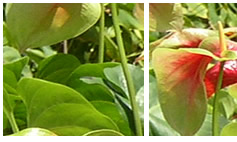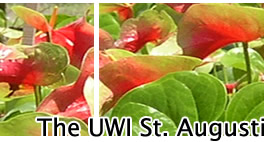 |
 |
||||
 |
 |
 |
|||
|
|
Genetic studies in the Caribbean Resistance to Bacterial Blight Recent work at the University of the West Indies, St Augustine has unraveled the genetic basis for resistance to the bacterial blight disease. Most of the anthurium cultivars (60) grown in the Caribbean have been genotyped and their level of resistance to Bacterial Blight determined at the foliar and systemic levels using a two-stage screening method. The levels of resistance identified have been shown to be correlated to field resistance scores obtained based on a farmer survey. The screening method developed and the understanding of the genetics of resistance will allow for targeted hybridizations between anthurium genotypes towards obtaining higher levels of resistance. The principles are already being practices in the breeding programme at Kairi Cut-flowers Ltd. A number of novel varieties that combine resistance to bacterial blight with other horticultural characteristics have been developed. Flower colour Work on the genetic basis of flower colour began at the University of Hawaii. Recent work at the University of the West Indies has led to the development of a new genetic model that aptly explains segregation ratios in all the crosses. The results also support parallel investigations on the molecular biology of flower colour in anthurium. Approximately, 50 anthurium cultivars have been genotyped with respect to spathe colour, which helps in the selection of parents in breeding programmes. This work is especially useful in that we can predict the segregation of spathe colours in progeny populations.
|
© 2004 - The University of The West Indies. All rights reserved. Disclaimer | Privacy Statement Telephone: (868) 662-2002 Fax: (868) 663-9684 |
|